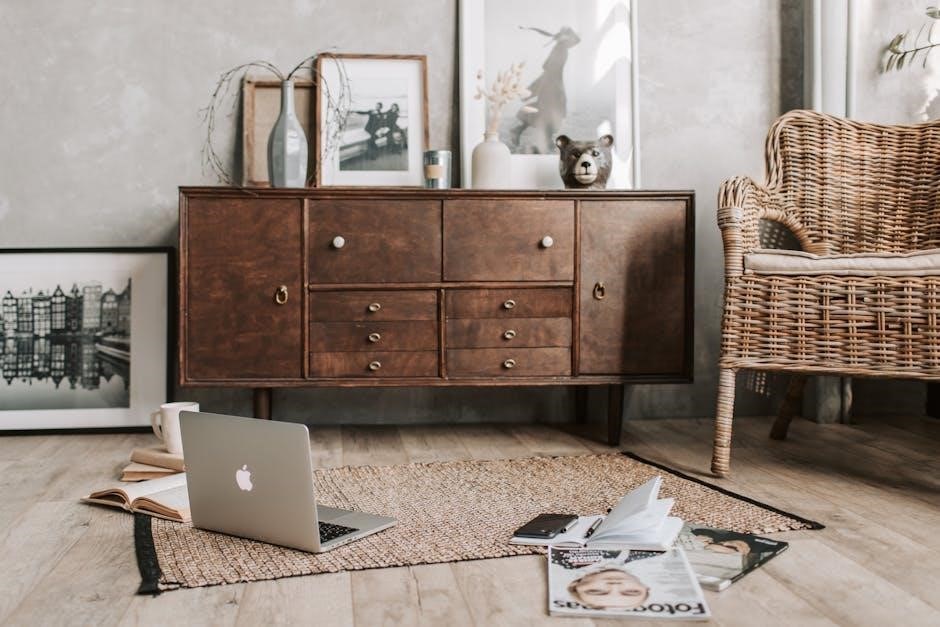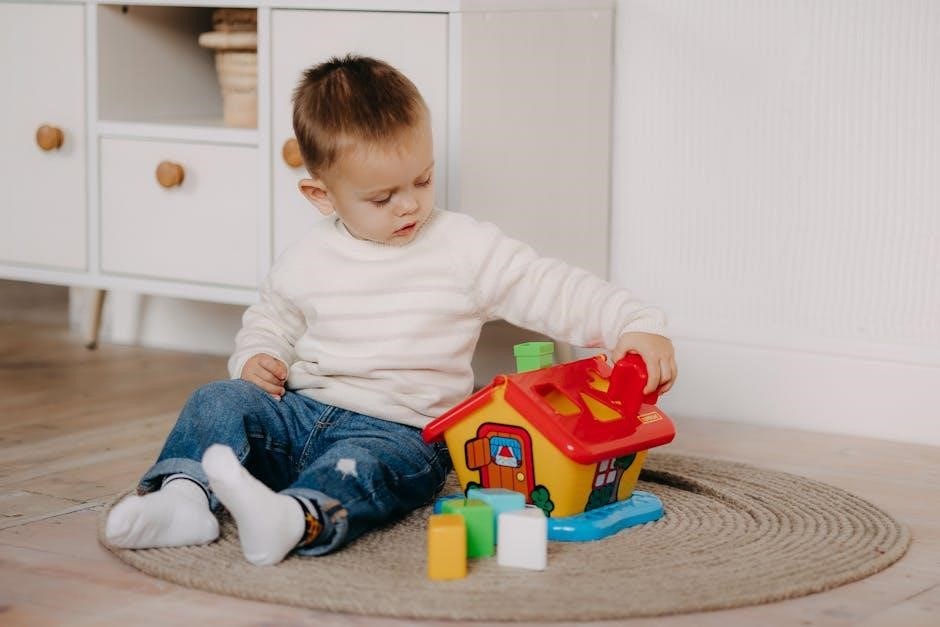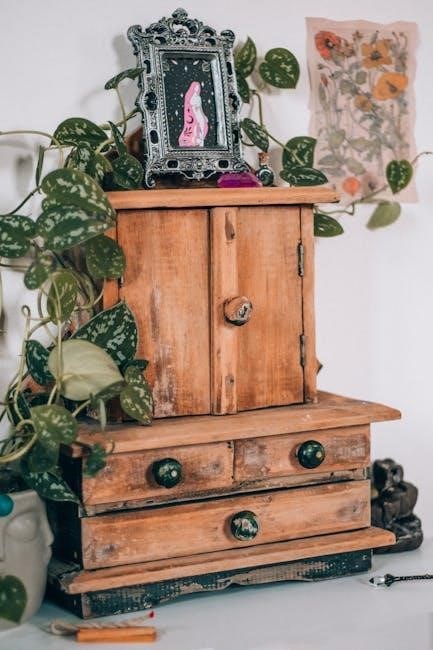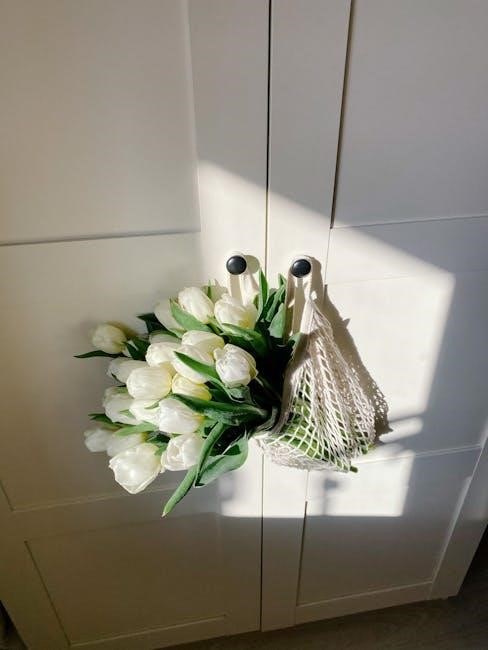
Proper cabinet knob placement enhances functionality and aesthetics, ensuring easy access and visual harmony. It influences user experience and interior design, making it a crucial detail in cabinetry installation.

Factors Influencing Knob Placement
Functionality, design consistency, and user comfort are key factors in determining knob placement. These elements ensure knobs are accessible, visually appealing, and aligned with the cabinet’s overall design and purpose.
2.1 Functionality and Ease of Use
Functionality is a critical factor in cabinet knob placement, ensuring they are easy to access and comfortable to use. Knobs should be positioned to minimize strain, with heights and locations that accommodate the user’s reach. For example, knobs on base cabinets are often placed 2-3 inches from the corner opposite the hinge, allowing easy gripping. Similarly, wall cabinets typically have knobs 2-1/2 inches from the bottom corner, ensuring they are within a natural hand-reach zone. This placement not only enhances usability but also prevents wear and tear from frequent use. Properly placed knobs ensure smooth operation, making daily interactions with cabinetry more efficient and convenient. By prioritizing functionality, knobs contribute to a user-friendly kitchen or bathroom design.
2.2 Consistency with Overall Design Aesthetic

Consistency with the overall design aesthetic is essential for a cohesive look in any space. Cabinet knob placement should align with the style and proportions of the cabinetry, ensuring visual harmony. For instance, knobs on wall cabinets are often centered horizontally on the door stile, creating symmetry. This placement complements the design while maintaining functionality. Additionally, the height of the knobs should match the overall aesthetic, such as placing them 2-1/2 inches from the bottom for wall cabinets or 2-3 inches from the corner for base cabinets. Consistency in spacing and alignment ensures the hardware blends seamlessly with the cabinetry, enhancing the room’s visual appeal. Proper placement avoids a cluttered or mismatched appearance, contributing to a unified and polished design. By aligning knob placement with the overall aesthetic, the space achieves a balanced and stylish look.

Standard Guidelines for Knob Placement
Standard guidelines ensure consistency and functionality, with knobs typically placed 2-3 inches from corners or centered on stiles, aligning with design aesthetics for a balanced and cohesive appearance.
3.1 Wall Cabinets
For wall cabinets, knobs are typically placed 2.5 inches up from the bottom corner on the side opposite the hinge, ensuring easy access and a balanced appearance. This standard placement enhances functionality while maintaining design consistency. Centering the knob horizontally on the stile promotes symmetry, contributing to a polished look. Consider door size, with smaller doors potentially using 2 inches and larger ones 3 inches. Accessibility is key, avoiding placement too high or low. Consistency across multiple cabinets maintains uniformity, tying into the overall aesthetic. Knob size and design may slightly adjust placement, ensuring no obstruction from nearby objects. This approach ensures knobs are both functional and visually appealing, complementing the space’s design seamlessly.
3.2 Base Cabinets
For base cabinets, knobs are typically placed 2 to 3 inches from the upper corner opposite the hinge on the door or drawer. This placement ensures easy access and comfortable use, especially for frequently accessed items. On standard base cabinets, the knob is positioned near the top edge, allowing users to grasp it without strain. For wide drawers, knobs or pulls are often centered at the top of the drawer panel, aligning with where the drawer rail begins. This central placement enhances functionality and maintains a balanced aesthetic. Consistency in knob placement across all base cabinets ensures a cohesive look. Proper positioning also prevents obstruction from nearby objects, making the space more user-friendly. By considering both accessibility and design, knob placement on base cabinets contributes to a seamless and functional kitchen environment.
3.3 Tall Cabinets
For tall cabinets, knob placement should prioritize both accessibility and aesthetic balance. Typically, knobs are positioned 2 to 3 inches from the bottom corner opposite the hinge, similar to base cabinets, but adjusted for the cabinet’s height. This placement ensures that the knobs are easy to reach without straining, even for taller individuals. On very tall cabinets, knobs can be centered vertically to maintain visual proportion and symmetry. Consistency in placement across all tall cabinets is key to maintaining a cohesive design. Additionally, aligning the knobs with other hardware in the space, such as pulls on drawers, can enhance the overall look. Proper placement ensures functionality while complementing the cabinet’s design, making tall cabinets both practical and visually appealing in any setting.
3.4 Wide Drawer Cabinets
For wide drawer cabinets, knob placement should emphasize both practicality and visual balance. Typically, two knobs are used, positioned symmetrically on either side of the drawer face. Each knob should be placed 2 to 3 inches from the respective corner (left and right) and centered vertically for consistent appearance. This setup ensures easy access and distributes the weight evenly, making it easier to pull the drawer open. The spacing should align with other hardware in the room to maintain design coherence. Avoid placing knobs too close to the edges to prevent them from looking out of place or obstructing the drawer’s operation. By adhering to these guidelines, wide drawer cabinets can achieve a harmonious blend of functionality and aesthetics, ensuring they are both user-friendly and visually appealing in any setting.

Tools and Materials Needed for Installation
Installing cabinet knobs requires specific tools and materials to ensure a precise and secure fit. Essential tools include a measuring tape for accurate placement, a drill with appropriate drill bits for creating pilot holes, and screwdrivers (both flathead and Phillips) for securing the knobs. An Allen wrench set may also be necessary for adjusting certain knob mechanisms. A small level ensures proper alignment, while a pencil is used for marking drill locations. Clamps can help stabilize the cabinet during the process. Materials needed include the knobs themselves, screws provided with the hardware, and optional decorative caps or spacers for added aesthetics. Safety gear like safety glasses is recommended to protect against debris. Having all these tools and materials ready ensures a smooth and efficient installation process, achieving both functionality and design consistency.
Common Mistakes to Avoid
When placing cabinet knobs, several common mistakes can compromise functionality and aesthetics. One major error is positioning knobs too close to the edge of the door or drawer, which can make them difficult to grasp comfortably. Another mistake is failing to measure accurately, leading to misaligned hardware that disrupts the visual balance. Ignoring the overall design consistency is also a pitfall; knobs should complement the style of the room and other fixtures. Additionally, placing knobs too low or too high can create accessibility issues, especially for taller or shorter users. Lastly, not considering the hinge location can result in knobs being obstructed when doors or drawers are opened. To avoid these errors, always measure carefully, align knobs symmetrically, and ensure they are positioned for optimal comfort and accessibility while maintaining design harmony.
Proper cabinet knob placement is a critical detail that enhances both functionality and aesthetic appeal. By considering factors such as ease of use, design consistency, and standard guidelines, homeowners and installers can ensure a seamless and visually pleasing result. Avoiding common mistakes, like improper measurements or ignoring hinge placement, is essential for a professional finish. With careful planning and attention to detail, cabinet knobs can elevate the overall look and usability of any space, creating a cohesive and functional environment. Whether updating existing hardware or installing new cabinetry, following these principles guarantees a polished outcome that meets both practical and stylistic needs.